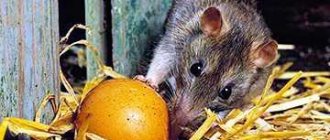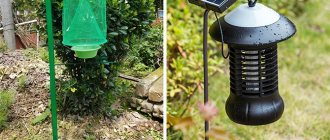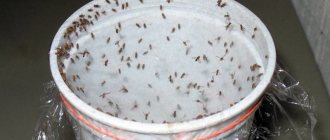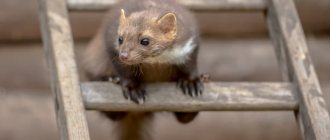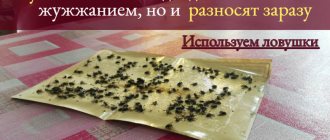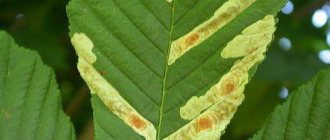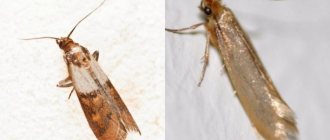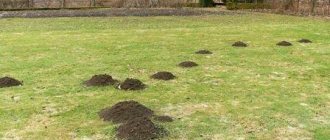The mole cricket, commonly referred to as cabbage weed or earthen crayfish, is a very large insect, reaching a length of 5 cm. It is nocturnal and prefers moist soil. When the air is warm enough, it is capable of flight and is especially active in May. While making underground passages, it gnaws at the root system of garden plantings, for which it received the title of a malicious pest. You can catch a mole cricket using homemade traps and trapping pits. Beer, honey, butter, and cereals are used as bait. The use of eggshells, repellent aromas, and planting of certain plants is also recognized as an effective method of control. All these means are applicable both in open ground and in greenhouses.
How to catch a mole cricket?
Gardeners catch insects in order to reduce their numbers, while fishermen use cabbage grass as bait for catfish and carp. There are several simple ways to catch mole crickets:
- The insect loves moist soil and especially heaps with cow manure and humus. Armed with a shovel, you should carefully turn over the layers of compost. Individuals leaving their shelters are collected and placed in a pre-prepared container.
- In the garden, it is enough to cover the beds with film or cardboard. After 2–3 days, a significant number of mole crickets will gather under the covering material. The number of “catch” depends on the speed of the catcher’s movements and reaction. Insects are very nimble and scatter quickly.
- You can lure the pest at night using a flashlight. To do this, a lighting device is suspended or installed in one area. The mole crickets will crawl towards the light; all that remains is to illuminate the crawling individuals with another flashlight and collect them.
- Another simple way to catch a mole cricket is to throw pieces of soil into the water, wait for the insect to float up and catch it with a net.
- Washing powder will help lure cabbage worms out of their burrows. If nests or underground tunnels are found, pour a solution prepared from 2 - 4 tbsp. l. any powder and 10 liters of water. The components of the mixture create a film and prevent the access of oxygen. After a few minutes, insects begin to leave their shelters en masse. To destroy them, use a shovel, literally cutting the mole cricket in half.
- An alternative to washing powder is soap solution. To prepare it, 100 g of tar or laundry soap should be crushed or grated and combined with 10 liters. water, stir until completely dissolved.
- You can also pour sunflower oil into the passages. First, add 20–50 mg of oil, then 8–10 liters of water.
It is not recommended to catch insects with your bare hands. In attempts to free themselves, mole crickets can painfully scratch the skin.
For storage, jars are used, the bottom of which is lined with wet sawdust. I use plant roots as food. It is advisable that each individual live in a separate container.
Application of chemistry
Sealing mole cricket burrows with cotton wool
The chemical industry produces a fairly large number of drugs used to kill mole crickets.
Almost all of them are broad-spectrum insecticides that can also destroy the following species:
- larvae of May beetles and bronze beetles
- wireworm larvae and adults
- black garden ants (breeding aphids and mealybugs)
A description of the drugs and the features of their use is given in the table:
Drug Active ingredient How to use
| Medvetox | Spectracid 25E | It is a red granular powder. Harmless to plants and many other species of earth animals, in particular earthworms. Placed between rows in long furrows up to 5 cm deep. Validity period is about 15 days. The action begins a few hours after application. |
| Anti-Medvedka | Imidacloprid | Large and small white granules. Consumption - no more than 20 g per 1 hundred square meters. Placed on the surface between the beds during planting. |
| Medvecid | Imidacloprid | Small purple granules. They are located in furrows no more than 3 cm deep between rows. The distance between the granules is 50-100 cm. Consumption is 10g per 1 sq. m. |
| Rembek | Imidacloprid and chlorpyrifos | Presents a malfunctioning strong-smelling bait. Consumption - no more than 25 g per 1 hundred square meters. Baits are placed in and around holes. |
| Boverin | Beauveria bassiana spores | A suspension is made from the substance, which is applied to plants and around mole cricket burrows. The spores of the fungus, falling on the skin of an insect, begin to germinate inside its body, which leads to death within a few days. Repeated treatment is carried out after 1-2 weeks. |
| Phenaxin-plus | Phosphothion | It is a strong-smelling white-yellow granule. Their laying is carried out at the stage of sowing seeds. Repeated treatment - 3 weeks after sowing (duration of the drug); in this case, the granules are simply placed near the stems. |
Any of the listed drugs (except Boverin) can be used in a mixture with edible bait - oatmeal, buckwheat or pearl barley porridge. Sunflower oil is also added to the bait. In the evening, the resulting mixture is laid out near the bear's burrows in the amount of 10-15 g per hole.
In addition, to combat mole crickets, acetylene is used, which is poisonous for the insect. To do this, 5 g of calcium carbide is placed in each hole and all holes are sealed with cotton wool or soft cloth, covered with earth on top.
When the substance reacts with water (in the form of rain or irrigation water), it decomposes into acetylene, which fills the mole cricket's burrows and passages. The gas quickly kills the insect.
Kerosene can also be used against mole crickets. However, this comes with some problems: due to the relatively high toxicity of the drug, it is not recommended for use in large quantities. You can fill no more than 1-2 holes on the site with kerosene; Up to 50 ml of substance is consumed for each hole.
How to make a mole cricket trap from manure
For cabbage weeds, dung beetles are a favorite habitat where they feel comfortable, lay eggs, and overwinter. In most cases, contamination of the site occurs through compost. There are several options for traps with manure that allow you to get rid of mole crickets.
First way
Recommended for use in August and early autumn.
- Dig a hole at least 50 cm deep.
- Cover the bottom with plastic wrap.
- Line the bottom with a layer of manure.
- Leave the hole open.
The mole crickets will crawl into the trap in order to spend the winter. When the temperature drops to sub-zero, a hole should be dug. You can spread manure around the area. The insects will not have time to dig deep tunnels and the entire population of pests will die under the influence of frost. There may be several such traps in the garden.
Second way
Such traps are effective both in spring and autumn.
- Dig a hole 0.5 - 0.6 m deep.
- Cover with plastic.
- Fill the third part with cow dung.
- Cover the hole with planks or any hard material, leaving intervals so that the mole cricket can crawl into the hole.
- Cover with covering material to prevent rain.
- A month later, the contents are removed along with the polyethylene and burned. A new trap is being built at the same place.
Third way
This option for using manure against mole crickets can be used in open ground beds or in greenhouse structures.
- Prepare containers: bowls, plastic bottles with the neck cut off, jars, buckets.
- Bury the container so that at least 1 cm remains from the edge of the trap to the surface of the soil layer.
- Fill the containers halfway with manure. To attract pests faster, pour beer or vegetable oil on top.
- Cover the top with thick material and secure by sprinkling the edges with soil.
- After 20–30 days, remove the traps and burn them.
How to use bird droppings against cabbage weed
There are several variations of the effective use of chicken manure:
- Burrows and tunnels are filled with fresh feces.
- Dilute 200 g of fresh litter in 10 liters of water. Fill the discovered nests and underground passages with the resulting solution.
- To prevent the appearance of mole crickets in the autumn, the soil is fertilized with bird droppings.
What kind of “beast” is this?
The mole cricket, scientifically called Gryllotalpa, is an insect with a rather repulsive appearance.
The length of its rigid body with wings varies from 5 to 7 cm. The insect's chest shell is hard, and allows the head to partially hide under its protection. The mole cricket’s head is “decorated” with strong horny jaws, framed by two pairs of tentacles, two large compound eyes and long antennae. The forelimbs of this insect are more developed than the others, and are designed for digging passages underground. The head, chest and upper surface of the insect's body are dark brown, and the abdomen and limbs are lighter, olive-brown. The mole cricket prefers well-fertilized, especially manured soils, and digs vertical passages in them, the depth of which can reach 100–120 centimeters. As a rule, such a passage ends in a horizontal chamber in which adult insects overwinter. The larvae overwinter in vertical passages at a depth of 60-80 cm.
Why was she called “Medvedka”?
This pest got its name because of its clumsy, profusely pubescent dark brown body. In addition, in some areas the mole cricket is called the “earthen crayfish” because of its jagged, serrated forelimbs in the form of ticks. Because of the special attention this pest gives to young cabbage plants, it is also called “cabbage weed” or “cabbage weed”. Young insect larvae are gray in color and have a huge appetite, for which they are nicknamed “tops.”
How is it dangerous?
The mole cricket happily feeds on seeds sown in the ground and underground parts of garden crops such as tomatoes, cucumbers, various types of peppers and eggplant. Plants damaged by this insect dry out and are quite easy to pull out of the garden. In crops such as potatoes, carrots and beets, the mole cricket chews through the stems, eats the roots and gnaws large cavities in the root crops.
The fact that there is a mole cricket in the area is evidenced by small hillocks of soil formed from rolled up lumps of earth.
When thinking about ways to combat mole crickets, you should remember that this insect can move not only underground. This pest is able to swim quite well in water, and also fly considerable distances at night.
Birds do not pose a threat to this insect, as it leads a secretive lifestyle.
Beer trap
According to farmers, the best bait for mole crickets is beer. With its help you can catch up to 15 individuals in one device. To make a beer trap you will need:
- 0.5 liters of cheap beer;
- 6 wide-neck plastic bottles, 0.5 l;
- 6 small pieces (30x30 cm) of plywood or linoleum to cover the hole;
- 6 pieces of dense linoleum 6x6 cm - backing for the bottle neck.
How to make a trap:
- Pour beer into 6 bottles.
- In places where mole crickets, their burrows or tunnels have been spotted, loosen and moisten the soil to a depth of 15–20 cm.
- Make holes in the prepared soil with a diameter of about 20 cm and a depth of 5–6 cm.
- Place beer bottles in the centers of the holes at an angle of 45°, making sure that the neck of the tilted container does not extend beyond the hole.
- Place a small piece of linoleum under the neck of each so that the insect can crawl into the trap without obstacles and not cover it with soil. If this is not available, wood chips and plywood are used.
- Cover the hole with the trap with any light-proof material: roofing felt, plywood, linoleum, tin.
- Cover the edges with soil. This will maintain moisture and twilight.
There is no need to monitor the contents of traps daily. It is enough to check them once a week. The caught individuals are burned, fresh beer is poured into bottles and installed in new places.
Banks
You will need 500 ml jars. Fill halfway with water. They dig throughout the garden or in separate beds at a distance of 50 cm. The neck should rise 5 mm above the soil or be completely level with it. Traps are checked daily.
On a note!
Water attracts mole crickets very strongly, but if the effect is weak, you can try porridge bait.
This mole cricket trap is the simplest, but no less effective. Additionally, other folk methods of control are used (using eggshells, etc.)
Trap with honey or vegetable oil
Made from a bottle or a jar.
- The walls on the inside are lubricated with honey, so it is more convenient to use containers with a wide neck.
- The prepared jars are dug into the ground, similar to the previous method, covered with dense material and insulated with straw. Cabbage girls who are not averse to eating sweets will not pass by such a treat. But they will no longer be able to get out of the container.
If the number of pests is small, traps are checked every 7–10 days. If there are a lot of mole crickets on the site, then an inspection is carried out every 2 days.
You can put containers with sunflower oil in the same way. The effect is similar to beer and honey.
On a note! The most effective trap for a mole cricket with honey is in the autumn. During this period, insects are preparing for winter and need increased nutrition.
Biological methods
The mole cricket has many natural enemies. First of all, these are birds. The greatest damage to the population is caused by rooks, crows, starlings and even ordinary chickens.
Hoopoe catching a mole cricket
It is recommended to let the latter out into the garden from time to time. Naturally, this needs to be done at a time when the chickens themselves cannot harm the crops; for example, before the beginning of periods of active growth of young plants, fruiting, harvesting, etc. Chickens are able to perfectly find mole crickets and their larvae and destroy them.
In addition, hedgehogs, lizards, shrews, moles and ants are involved in the destruction of mole crickets. Attracting, for example, a hedgehog to your garden is very simple - just place a saucer of milk in the garden every evening.
With birds, everything is also relatively simple - birdhouses or nest boxes on the site will significantly improve the situation with any harmful insects, including mole crickets.
There is also a highly specialized enemy of the mole cricket – the Larra anathema wasp. This type of wasp lays eggs exclusively in mole crickets, where their development occurs. After the larva matures, it leaves the host, who soon dies.
Larra anathema wasp, a natural enemy of the mole cricket
This insect does not pose any harm to humans, plants and other inhabitants of the garden, therefore, if you encounter this wasp, there is no need to destroy it. The wasp is quite widespread in the south of the European part of Russia, in the Krasnodar Territory, as well as in Ukraine, Moldova, and Georgia.
If the issue of counteracting mole crickets is very pressing, you can also try to use wasps to combat them. Legumes are used to attract wasps. larra” is best attracted to a plant called “partridge pea”.
Catching mole crickets using cereals
This trap is very easy to make with your own hands. It shows the greatest effectiveness in spring, warm times.
- Cook any of the cereals until half cooked: pearl barley, millet, rice or peas. To enhance the effect, you can add boric acid or an insecticidal preparation. To make the product attractive by smell, add unrefined vegetable oil to it.
- Dig small holes and moisten.
- Place a handful of prepared bait in each.
- Cover with plywood and linoleum. Sprinkle the edges with earth to secure. Such measures will help retain moisture and keep out sunlight.
- In the morning, the covering material is removed and the caught individuals are collected.
Bait
Mole cricket bait The trap will not work or will be ineffective if the bait is not offered to your liking.
Smell requirements
The contents should be fragrant. To enhance the smell of any prepared product, you need to add a few tablespoons of vegetable oil. Other scents may repel insects.
Beer bait
The best remedy for mole crickets is beer. There is no need to buy expensive drinks; pests will not appreciate this gesture. You can get by with the cheapest option. 50 ml is poured into trap bottles, this is enough for insects to smell the smell. Or simply bury a beer bottle with drops of the drink left in the ground as a trap.
Porridge for bears
The bait is made from cereals. Prepare crumbly porridge. Cook until half cooked, cover with a lid, wrap in a towel. Place in small handfuls in a trap. Rice, millet, barley, peas are suitable. To enhance the effect, a poisonous agent is added to the porridge. The simplest option is boric acid. The substance is tasteless and odorless and will do nothing to repel the mole cricket. But it will begin to act when it enters the stomach.
Dish with a surprise
You can make a pea treat with a little surprise. Any toxic agent is diluted in water. Parachute approaches, Regent. Soak the peas for a day. Scattered into traps. This option is suitable for those who do not want to bother with live insects. The trap will already contain dead pests. The poison is effective for 3 hours.
Any type of trap gives a good result, but does not guarantee complete cleansing of the land from pests. Works great in tandem with other control methods.
Rating( 2 grades, average 5 from 5 )
How to catch a mole cricket with a bucket
Another accessible way to lure out a mole cricket yourself. It is used in May and June, when cabbage mushrooms become active, are absorbed in mating games and their years are observed.
- A wide bucket with a soap solution is installed on the site.
- A bright lantern is placed above the bucket.
Attracted by the bright light, individuals hit the lighting fixture and fall into soapy water, from which they can no longer get out. Judging by the reviews, during the peak season it is possible to collect half a bucket of mole crickets in one night.
Soapy water
You can wait for the mole cricket to come out of the hole on its own following the smell of the bait, or you can help her decide on her own.
Prepare a soap solution. Add any soap product to a bucket of water - powder, soap, washing gel, etc. Find mole cricket holes and pour water into them.
Sensing danger, mole crickets will crawl out of the emergency entrance to the surface. At this moment, you should chop them with a shovel, breaking the body into 2 parts. Insects that did not have time to escape emerge from their holes along with the water, already dead.
Eggshell
Traps with eggshells are good at saving garden plantings from mole cricket invasions.
- Grind the eggshells and sprinkle them with sunflower oil. You can add cereal, cooked until half cooked.
- Place bait in the ground.
- After eating the bait, the insects' digestive system is injured and they die.
On a note! An easier way to use eggshells involves burying the crushed product in the soil. Constantly bumping into sharp objects, mole crickets will look for other habitats.
Regular loosening of the soil
The mole cricket prefers well-moistened areas rich in humus.
Therefore, the gardener
needs to loosen the soil on a regular basis,
which will not only prevent the formation of a surface crust, but also destroy the passages of this insect, which soon leaves the area.
Photo of loosening the soil
In the fall, it is recommended to dig up the entire garden by hand or with a walk-behind tractor, being sure to turn over and break up the layer of soil,
which will mechanically destroy all pests. This work must be carried out immediately before the onset of frost, after which the mole cricket dies from the cold in the frozen ground.
Summary
Mole cricket traps help to significantly reduce the population size, but they are not able to completely rid an area of pests. For effective control, comprehensive measures are used: the roots of plants are treated with insecticidal preparations before planting, and the soil is loosened and dug up in a timely manner. To deter them, chrysanthemums and marigolds are planted, aspen stakes are installed, and the soil is mulched with pine needles. To prevent mole crickets from entering the greenhouse, deep furrows are made along the perimeter of the structure, sprinkled with sand and sprayed with kerosene.
Repellent methods
Folk method of struggle
The mole cricket, like all insects, is able to distinguish odors well. There are odors that are both pleasant and unpleasant for insects. The list of the latter is quite extensive - it includes both the smells of certain substances and the smells of certain plants.
Therefore, to avoid the appearance of an uninvited insect, it is recommended to use the following methods:
1
In the spaces between the rows, as well as along the perimeter of the site, you can plant plants that are “unpleasant”
- calendula
- marigold
- chrysanthemums
2
To protect potato crops from insects, after flowering, you need to place branches of coniferous plants between the rows:
- fir
- ate
- pine trees
Mulching with pine needles between rows
3
Make stakes up to 40 cm long from freshly cut aspen or alder branches (at least 30 mm thick). They must be buried at a distance of at least 25 cm at a distance of no more than 1.5 m from each other. In this case, the bark should remain on the stakes. The stakes should be renewed as they dry out.
4
It is recommended to fill the mole cricket's passages with a solution of onion peels
5
When planting plants, it is recommended to add a peeled clove of garlic under each plant.
6
Instead of garlic, you can put small fish (not salted, of course) under each plant.
7
Greenhouses should be fenced around the perimeter with furrows 5-10 cm deep, into which naphthalene or sand moistened with kerosene should be poured.
8
For root plants (beets, carrots, parsley, etc.), it is recommended that the first watering be done with a solution of iodine in water (10 drops of iodine are dissolved in 5 liters of water)
Wind structures
Wind repellent for mole crickets
Mole crickets do not really like vibrations and noise in occupied territory. Therefore, various repellers occupy a separate niche among anti-casserole remedies. Such a device produces sound vibrations that force the mole cricket to leave the area. They are quite expensive, about 500 rubles for the simplest model.
